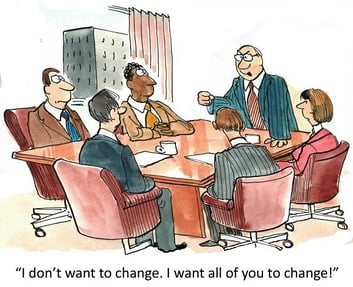
1. Set a Purpose, Vision, Strategy & Plan
Do you have a clear and inspiring vision that your people can identify with? Is this something that is widely understood within your business? Do people know the part they play within the larger picture and how they contribute to the organisation’s goals?
This is the very first step. Your people, especially the younger generations want to feel they are contributing to something bigger than themselves. Meaning and purpose is important to them and it also engenders a deeper connection and therefore commitment to what you are trying to achieve. Enabling everyone to uniformly move toward your true north will eliminate ‘busy fools’, working tirelessly with minimal impact.
2. Listen…
Is your listening ear on throughout the day or have you got all the answers? When you ask a question, are you truly hearing the response or are you judging it based on what you 'know' to be true?
You’d be amazed how much knowledge, expertise and valuable insight lies within your business. You probably have a 10,000 foot view of your organisation which gives you the necessary perspective for certain decisions. Your people however have a 5cm view, knowing the intricate ins and outs of what actually happens in the business versus what the policy, strategy or process map says should happen. Inviting their thoughts and truly listening will provide you with a perspective and insight that would cost you tens of thousands in consultant fees. You have extremely valuable resources at your finger tips, use them!
3. Don't treat people like mushrooms.
Keeping them in the dark and feeding them bulls*t is a surefire way of creating apathy, a victim mentality and reactive behaviour. This is rife in organisations with leaders who feel they are the sole decision makers with all the answers and nothing to learn. They tend to make decisions behind closed doors, tell their people what's been decided and then task them with actions, with no reason or logic explained.
Acting on orders with no questions asked may work on the battlefield, however in an organisation where you want people to take ownership and think for themselves, this is the antidote. I very much doubt you hired people because they 'didn't know how to think'... so let them do the thing you hired them to do. Let them use their brain!
Besides, people will fill any gaps in information with the worst possible scenario creating panic and insecurity which reduces productivity and kills creativity. Share what you know, even if it’s not the full picture yet. Bring people in early on, invite their thoughts and opinions, enable them to co-create the solution. Yes it may take a little longer and can’t be used in all situations, however in the medium to long term it will increase ownership and reduce your workload as people begin to understand the bigger picture and make their own decisions aligned to it... win win!
4. Set the 'What', explain the 'Why' and let go of the 'How'
I hear leaders time and time again complain that their people don’t take ownership. "They don’t take initiative", "They do the bare minimum", "They don't have the passion". If people feel their ideas or solutions have fallen on deaf ears, or they are given such little information offering a very narrow view of the organisation, they will shy away into the background and give up, doing the bare minimum to survive... or they will leave!
Try flipping it around. As a leader your role is to paint the inspiring vision, set the direction including boundaries, explain the reasoning behind it and then let go… Let your people take the reigns and define ‘how’ they will achieve this on their own. Stay close if they need you however don’t dictate every little permeation of the solution. This will take a while to master for yourself and your people, especially if they’ve been in a ‘tell’ environment. However once achieved, it’s magic to watch!! Once again this will save you so much time so you can focus on all the valuable things you need to rather than get dragged down into the weeds.
5. Offer equal focus on the good and not so good
If you want people to step up and lift their head above the parapet… think about how you offer feedback and what you offer it on. If you constantly focus on what’s gone wrong and who's at fault, you will be amazed at the amount of time and energy wasted on the non value add activity of "cover your own backside"... think cc’ing the world in on every email, and we all want less emails! You will also have a whole lot of ‘spin’ which is very dangerous for your organisation. You need to know the real picture in real time, not when the proverbial 'sh*t hits the fan'!
Catch people doing the right thing and publicly praise them on exactly what it is they are doing that’s working. This ensures they, and those around them repeat the positive behaviour. If you need to offer constructive feedback, once again be specific and do it in real time. There is no point waiting a week when you both have forgotten the details of the situation. Celebrate successes, show people you notice when things go great, as well as when they go wrong!
For more information on the steps required to create the culture you know you want and need, download your very own checklist below.


